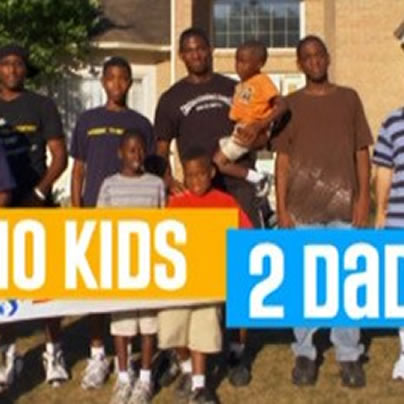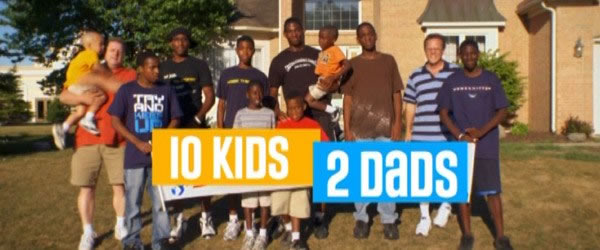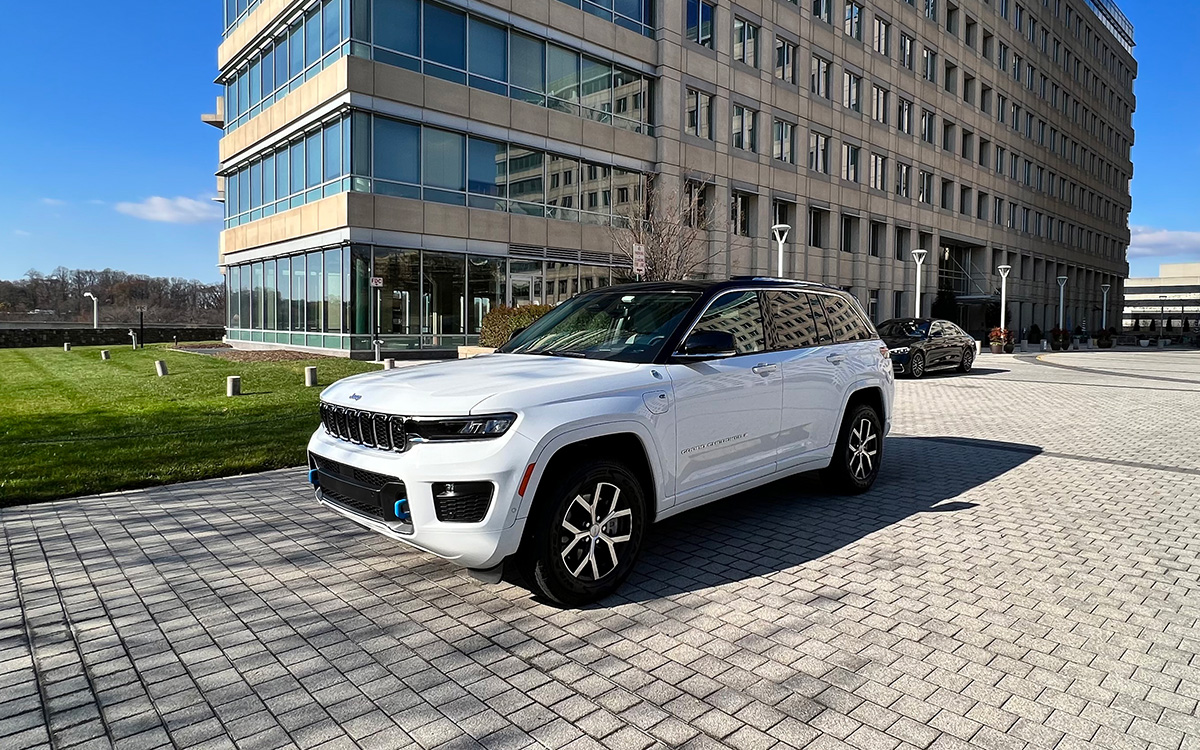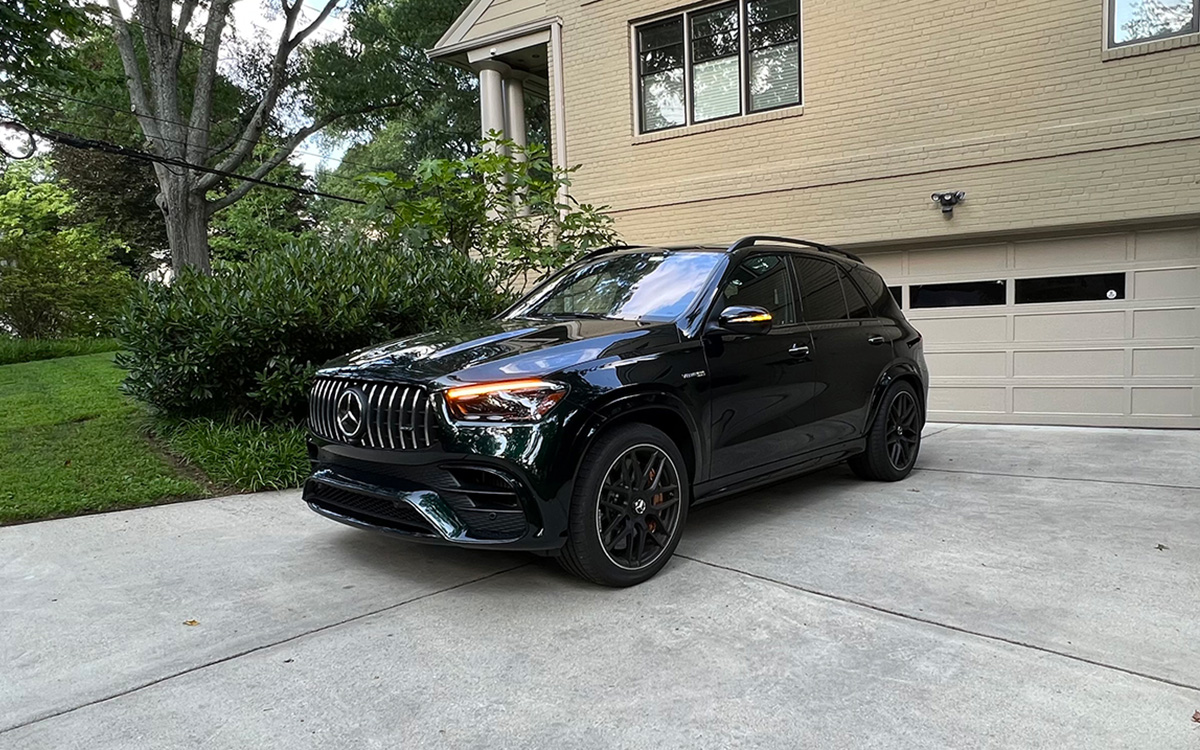Living
10 kids, 2 dads
Gay couple takes Father’s Day to a whole new level


Clint McCormack and Bryan Reamer are raising 10 kids in Michigan. (Photo courtesy the couple)
Trying to do a phone interview with Clint McCormack and Bryan Reamer, the two parents who were featured in OWN’s “10 Kids, 2 Dads” reality special last year, is a lot like trying to get honey out of a bee-lined hive. You’re not going to have an easy time of it. One kid comes in asking about food, another interrupts to talk about schoolwork, a third has just awoken from a nap and wants attention.
Still, somehow, the dads manage to live in this sort of controlled chaotic environment and create a loving family atmosphere where everyone is happy.
As a committed gay couple living in suburban Michigan, the couple knew they wanted to start a family, but 10 kids and nonstop commotion wasn’t exactly what they had envisioned.
What might seem crazy to most just felt right to the Farmington Hills couple, that originally set out to adopt just one child before eventually winding up with their 10 boys. McCormack comes from a family of six children while Reamer has just a brother, but both wanted to raise a family.
“We never intentionally wanted to adopt 10 children; it was the furthest thing from our minds,” McCormack says. “We thought maybe two or three max, but it just happened.”
After looking into foster children originally, McCormack found a place where they would be connected with birth mothers and in 1998, they adopted Keegan at his birth. Not satisfied to have an only child, a year later, they decided to look at adopting another child.
McCormack next found an agency in New Jersey to help the couple be matched with a child who could be a sibling to Keegan. Instead of one, the agency offered twins, Kenny and Mark (now 19).
“I decided to wait until I got the paperwork until I said anything to Bryan,” McCormack says. “Initially, he was a little wary of it, but we took the next step and met them and decided to proceed.”
No sooner was the twins’ adoption finalized when they got another call from the agency about a 3-year-old who they couldn’t find a home for. A caseworker came to their home, dropped off the kid and said, “I’ll see you on Sunday,” and then just left.
“He was not saying anything and I called Bryan and told him to hurry home. I noticed his diaper was wet and when I went to change it, I noticed he had leg braces on. I was never told that,” he says. “We brought him to a pediatrician the next day. He was really frail and going home, I was crying, saying I couldn’t adopt him because he’s going to die on us, and what would that do to our kids and I couldn’t handle it.”
Reamer knew that they couldn’t send him back. Being the more practical of the pair, he laid out his case that if they brought him back, he would die and the boy needed their love. Not long after, Caleb became son number four. Today, their “miracle kid” is walking normally and loving life.
“I thought our family was complete at that point,” McCormack says. “Maybe a year later, we got another call.”
The situation presented to them was that the agency had three brothers and they couldn’t find a home that would take in all three. They wanted Reamer and McCormack to consider adopting them, because if they didn’t, they would have to be split up.
“I called Bryan right away and told him they were going to split these kids up, and they were 7, 8 and 9, and you can’t do that to a kid. So, we started the whole process again,” McCormack says. “That’s how we got Seth (now 17), Garrett (now 18) and Graeme (now 19).”
With seven boys in the house, all becoming young men, McCormack started to yearn for the patter of little feet around the home again. He really wanted a baby — and a girl. The latter wouldn’t happen, but over the next few years Hayden (now 6), Liam (now 8) and Cooper (now 4) joined the family.
Before any of their adoptions went through, the couple asked themselves three questions:
“Can we do it financially? Can we do it physically? Can we do it emotionally?” Once an honest yes could be agreed upon, they knew it was in the cards.
“We are not adopting any more children,” McCormack says. “We have been offered two more children but we’ve turned them down. We are talking about what we want to do when we retire and stuff, and it’s like no more kids.”
The family lives in a four-bedroom house with two-and-a-half baths, and the oldest boys are currently in college and ready to move out. All the children have cell phones except the two little ones and they all constantly stay in touch with one another so everyone is always accounted for — at least as best you can with teenagers.
The two play to each other’s strengths to keep their home running smoothly. McCormack (or Papa as the kids call him) takes on the role of homemaker and chauffeur, while Reamer (Daddy) helps with homework and sports and is the disciplinarian of the household.
Reamer says his favorite thing about being a dad is when one of the younger kids comes up to him unsolicited and gives him a hug and kiss and says, “I love you Daddy.”
“Or when one of the older kids asks an interesting question. It gives me the opportunity to present different answers depending on situations,” he says. “This challenges them to broaden their scope of possibilities to evaluate when coming to a conclusion about something.”
Then he enjoys a lot of other dad-type things like sledding or attending sporting events.
“We always wanted children and when you want something, you make it work,” McCormack says. “We have really good kids. We were told things about their past where other people may have run away from, but we are very lucky.”
Think your life is consumed with kids’ activities? Imagine what McCormack and Reamer go through over the course of a week. There are sports, music lessons, school functions, community events, driving tests, play dates, doctor’s appointments and even college visits. And a lot of trips to the grocery store.
“I spend my days as a taxi driver,” McCormack says. “I try to remember everything but sometimes things fall through the cracks. Some have work, some have school, some have sports. I know where the kids are all the time, but I’m constantly being reminded I need to be here or there at a specific time.”
During the song “It’s a Hard Knock Life” from the musical “Annie,” there’s a lyric that goes, “Santa Clause we never see, Santa Claus what’s that, who’s he?” It’s something that hit very close to home for the two dads when they were first adopting their family.
“When we adopted our three together they didn’t know what birthdays were, they didn’t know what Christmas was, they didn’t know what Thanksgiving was, and they were 7, 8 and 9,” McCormack says. “They never experienced holidays. I was so dumbfounded that there are children in the states who don’t get anything for Christmas or experience Thanksgiving or Easter.”
Because of that, every Christmas the two dads and their 10 sons provide as many Christmas presents to foster children as they can through their foundation, Cee Bee Enterprises. Last year they provided gifts to more than 145 kids.
You would think that having 10 boys in the house would put a strain on the couple’s love life, but Reamer says that he and McCormack plan time together each day and still find time to do things away from the kids.
“We go out to dinner on Friday night and we have another home and our children are old enough where we can go up to our cottage for a weekend and the older ones can watch the littler ones,” he says. “We check on them constantly.”
As for the show on the Oprah Network, McCormack says it was a fun experience for everyone involved. Primarily shot in April 2012 in their former Canton home, the special chronicles the McCormack-Reamer family’s daily life, which includes all the madness you’d expect from a 12-person, two-dog household.
“Our reason for doing it was to show people that you can get great kids out of foster care,” he says. “We wanted people to see that it’s just like everyone else’s family.”
Real Estate
The rise of virtual home tours
Adapting to changing consumer preferences in spring real estate

In today’s dynamic real estate market, the spring season brings not only blooming flowers but also a surge of activity as buyers and sellers alike prepare to make their moves. However, in recent years, there’s been a notable shift in how consumers prefer to explore potential homes: the rise of virtual tours.
For the LGBTQ community, these virtual experiences offer more than just convenience; they provide accessibility, safety, and inclusivity in the home buying process.
Gone are the days of spending weekends driving from one open house to another – unless that’s your thing of course, only to find that the property doesn’t quite match expectations. With virtual tours, you can explore every corner of a home from the comfort of your own space – find something interesting? Schedule a showing with any LGBTQ Realtor at GayRealEstate.com.
This is particularly significant for LGBTQ individuals, who may face unique challenges or concerns when attending in-person showings. Whether it’s the ability to discreetly view properties without fear of discrimination or the convenience of touring homes located in LGBTQ-friendly neighborhoods across the country, virtual tours offer a sense of empowerment and control in the home buying process.
Moreover, virtual tours cater to the diverse needs of the LGBTQ community. For couples or families with busy schedules or those living in different cities or states, these digital walkthroughs provide a convenient way to view properties together without the need for extensive travel. Additionally, for individuals who may be exploring their gender identity or transitioning, virtual tours offer a low-pressure environment to explore potential living spaces without the added stress of in-person interactions.
At GayRealEstate.com, we understand the importance of adapting to changing consumer preferences and leveraging technology to better serve our community. That’s why our agents offer an extensive selection of virtual tours for LGBTQ individuals and allies alike – visit our website, choose an agent and within minutes you’ll have access to the Multiple Listing Service (MLS) via their website.
From cozy condominiums in bustling urban centers to sprawling estates in picturesque suburbs, virtual tours showcase a wide range of properties tailored to diverse tastes and lifestyles.
In addition to virtual tours, GayRealEstate.com provides comprehensive resources and support to guide LGBTQ buyers and sellers through every step of the real estate journey. Our network of LGBTQ-friendly agents is committed to providing personalized service, advocacy, and representation to ensure that all individuals feel respected, valued, and empowered throughout the process. Plus, we are happy to provide a free relocation kit to any city in the USA or Canada if you are a home buyer.
As we embrace the spring season and all the opportunities it brings in the real estate market, let’s also celebrate the power of virtual tours to revolutionize the way we find and experience our future homes. Whether you’re searching for your first apartment, forever home, or investment property, GayRealEstate.com is here to help you navigate the exciting world of real estate with confidence, pride, and inclusivity.
Jeff Hammerberg is founding CEO of Hammerberg & Associates, Inc. Reach him at [email protected].
Advice
Should I divorce my husband for the hot new guy in our building?
Debating whether to leave or stay after the sex goes cold

Dear Michael,
I’ve been with my husband for 10 years and the sex is pretty much gone. It stopped being exciting a long time ago and pretty much the only time we ever do it is with the occasional third.
A really hot guy moved into our building about a year ago. We would see each other sometimes in the elevator or at our building’s gym and we started talking and really hit it off. Mark is 15 years younger than I but we seem to have a lot in common. We started hooking up and the sex is amazing.
I haven’t told my husband because it’s breaking our rule about no repeats. I have to say that the secrecy is hot. It’s kind of a thrill to take the elevator upstairs when I say I’m going on an errand. But it’s more than that. I have a connection with Mark that is far more amazing than what I have ever felt with my husband. Not just the sex. We just enjoy being together, talking about anything and everything.
My husband went to visit his family last weekend and I spent the whole time with Mark. Since then I can’t stop thinking that I want to leave my husband and be with Mark.
Part of me thinks this is a crazy mid-life crisis. I mean, this kid’s in a totally different place in life. But we have mind-blowing sex and a fantastic connection. I’d like your thoughts on how to proceed.
Michael replies:
You’ve got a lot to consider.
First: Sex with a long-term partner changes over time. It tends to be less about erotic heat and more about the connection with a person whom you love. In other words, it’s being with the person you’re with that makes the sex meaningful and even great. Having a good sexual relationship with a long-term partner comes far more from a heart connection than from a crotch attachment.
Second: You seem ready to throw your relationship under the bus pretty quickly, without addressing other problems in the relationship besides sex. When you are sneaking around, lying, and rule-breaking , I don’t see how you can look your husband in the eye; and if you can’t look him in the eye, you certainly can’t have even a half-way decent relationship.
Yet another point to consider: Affairs pretty much always seem more exciting than marriage. The partner is new, which almost automatically makes the sex hotter; the secrecy is a thrill; and you don’t have to deal with paying the rent, house chores, and all the petty annoyances of living up-close with someone day-in, day-out.
You are bringing lots of energy to your affair, and everything about it is exciting. You are bringing no energy — at least no positive energy — to your marriage. You get what you put into a relationship.
Divorce is not something that should be entered into lightly. Be aware that if you leave your husband for Mark, you will no doubt find over time that the sex becomes less exciting and that the connection is not always fantastic. No surprise, 75 percent of marriages that begin with affair partners end in divorce. While I don’t think statistics predict what will happen to any particular couple, believing that you will have a significantly better relationship with your affair partner than you did with your husband sets you up for likely disappointment.
Many gay men focus on “hot sex” as the big draw, pursuing a lot of sex with a lot of men, and/or pursuing an ongoing series of relationships that last until the sex cools. If that’s what you want, that’s fine. But it’s a different path from pursuing a close and loving long-term relationship, which involves knowing someone well and having him know you well; collaborating on getting through the hard stuff life throws at us; finding ways to make peace with disappointment; and consistently striving to be someone worth being married to.
How to proceed? While you are the only person who should make that decision, I would suggest that whatever your choice, keep in mind that marriage can be more than what you’ve made of it, so far.
Michael Radkowsky, Psy.D. is a licensed psychologist who works with couples and individuals in D.C. He can be found online at michaelradkowsky.com. All identifying information has been changed for reasons of confidentiality. Have a question? Send it to [email protected].
Autos
Sport haulers: Jeep Grand Cherokee, Mercedes GLE-Class
Updated cabins, adept handling, and more

Now that March Madness and the Masters are over, it’s time for, well, everything else. For my husband and me, this means water sports, as in kayaks and rowing sculls, which is why we trekked to the Potomac for the George Washington Invitational regatta last weekend.
Alas, high winds splashed cold water on the event, canceling much of it. But there was still plenty of spirited camaraderie to rival “The Boys in the Boat.”
And I was reminded of my time years ago as a rower with D.C. Strokes, ferrying teammates to races up and down the East Coast. Back then my ride was a dated, rather cramped four-door sedan.
If only we could have paddled around in a sporty SUV like the two reviewed here. Now that would have been some smooth sailing (wink-wink).
JEEP GRAND CHEROKEE
$40,000
MPG: 19 city/26 highway
0 to 60 mph: 7.5 seconds
Maximum cargo room: 37.7 cu. ft.
PROS: Updated cabin, adept handling, strong towing
CONS: So-so gas mileage, no third row, pricey trim levels
IN A NUTSHELL: Rough, tough and buff. It’s doesn’t get much more butch than a Jeep. This year’s Grand Cherokee is no exception, with rugged looks, expert off-road capability and better-than-average towing capacity of 6,200 pounds.
There are a dizzying number of trim levels—more than a dozen—starting with the barebones base-model Laredo at an affordable $40,000. The lineup tops out with the Summit Reserve 4xe PHEV, which is almost twice the price at $76,000 and one of various plug-in hybrid versions available. Those plug-in hybrids can drive up to 25 miles on all-electric power before the four-cylinder gas engine kicks in. Otherwise, you can choose from a standard V6 or V8. Gas mileage on all trim levels is basically the same as the competition.
Where the Grand Cherokee really shines is in the handling. More refined than a Wrangler but less lavish than a Land Rover, this Jeep maneuvers just as well on city streets and highways as it does on bumpier terrain.
I tested the mid-range and mid-priced Overland, which comes standard with four-wheel drive and large 20-inch wheels. It also boasts a slew of niceties, such as quilted upholstery, panoramic sunroof and high-tech digital displays. These include a 10.25-inch infotainment touchscreen and rear-seat entertainment system.
The nine-speaker Alpine stereo, designed specifically for the Grand Cherokee, is pleasing. But I really wanted to hear the boffo 19-speaker McIntosh surround-sound system that Jeep also offers. Sigh, it’s only available on the premium Summit trim level.
MERCEDES GLE-CLASS
$64,000
MPG: 20 city/25 highway
0 to 60 mph: 6.6 seconds
Maximum cargo room: 33.3 cu. ft.
PROS: Lush interior, silky-smooth suspension, speedy
CONS: Some confusing electronics, tight third row, many competitors
IN A NUTSHELL: For a more high-class hauler, there’s the Mercedes GLE-Class. This midsize SUV is similar in size to the Jeep Grand Cherokee. But instead of seating five passengers, the GLE can carry up to seven. Sure, legroom in the optional third row may be tight for taller travelers, but it’s perfect for a cocky cockswain or two.
Six trim levels, ranging from the base-model GLE 350 to two high-performance AMG models. For eco-conscious buyers, the GLE 450e plug-in hybrid arrived earlier this year and can run on battery power alone for almost 60 miles.
My test car was the top-of-the-line AMG 63 S 4Matic, a head-turner in every way. Priced at a whopping $127,000, this GLE looks best in glossy black with the Night Package, which includes tasteful jet-black exterior accents and matte-black wheels. To complete the Darth Vader effect, there’s a deep, menacing exhaust rumble that’s downright threatening.
You expect such a ride to be wicked fast, and it is: 0 to 60 mph in a blistering 3.7 seconds. Yet the carbon ceramic brakes with their devil-red calipers are equally impressive in slowing things down quickly.
Inside, each GLE comes with two large digital displays on the elegantly sculpted dashboard. My favorite feature is the “Hey Mercedes” digital assistant, which responds to voice commands such as opening or closing the sunroof, operating the infotainment system or activating the climate controls.
It’s hard to find sport seats that are more comfortable, especially with the heavenly massage function (though those massage controls could be a bit more user-friendly.) For AMG models, the seats come with red-contrasting stitching and red seatbelts—a nod to the devilish demeanor under the hood.
Considering all the SUVs available in showrooms, few make quite the splash of a GLE.





















